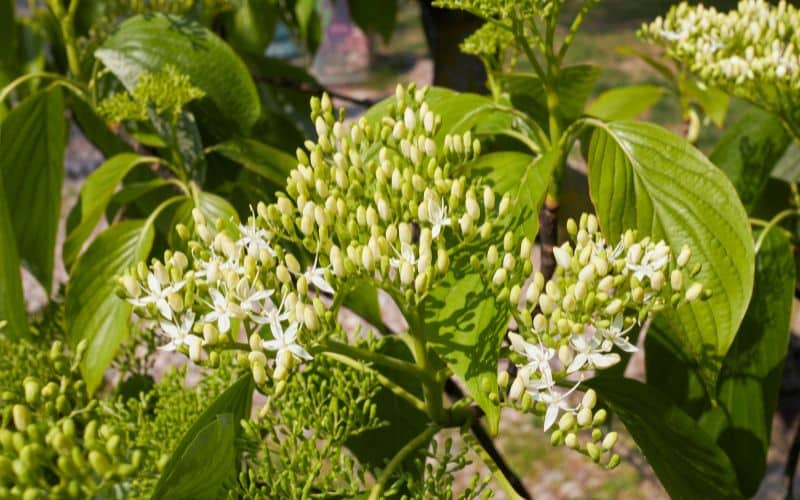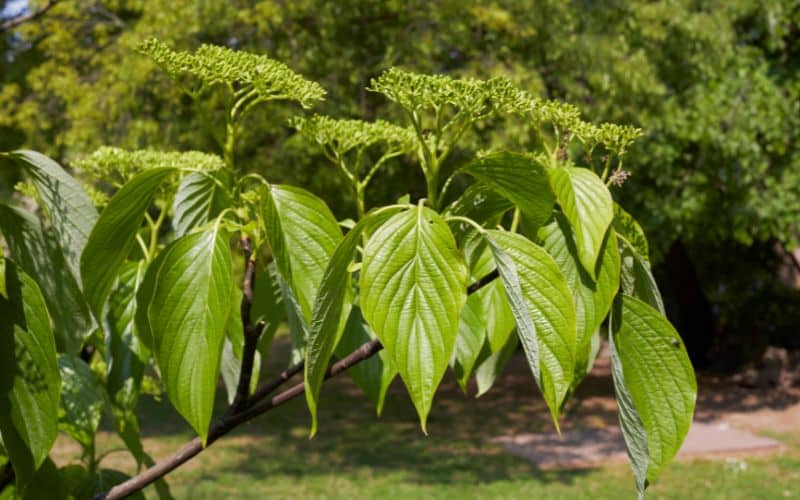
If you’re looking to add a touch of elegance and intrigue to your garden, the Pagoda Dogwood could be the perfect addition. Native to Ontario, this unique tree is known for its distinctive horizontal branching pattern that resembles a pagoda – hence the name.
Renowned for their beauty across all seasons, Pagoda Dogwoods boast delightful clusters of white flowers in spring that transform into dark blue berries by summer’s end. Come autumn, you’ll witness an impressive display as leaves turn from green to deep red or purple.
Remember though – it’s not just about aesthetics! The Pagoda Dogwood provides essential habitat and food for local wildlife too. So while you’re admiring your new tree’s good looks, rest assured knowing you’re also doing your bit for Ontario’s ecosystem.
Understanding the Pagoda Dogwood Species
Diving into the world of horticulture, you’ll quickly realise that there’s a vast array of species to discover. One such captivating specimen is the Pagoda Dogwood, known scientifically as Cornus alternifolia. This deciduous shrub or small tree thrives in Ontario and across other parts of Canada.
Characterised by its layered horizontal branches and distinctive growth habit, it’s often referred to as the ‘pagoda’ due to its resemblance to traditional Asian temples. You’d be hard-pressed not find this beauty adorning local parks or residential landscapes in Ontario!
What sets this species apart? Its unique features for starters! Let’s take a look:
- Flowers: Come springtime, expect clusters of creamy-white flowers that burst into life on your Pagoda Dogwood.
- Leaves: The leaves are dark green with paler undersides and they turn a stunning purplish-red come autumn.
- Fruit: As summer gives way to fall, bluish-black berries appear which provide an important food source for native birds.
A fact worth noting about these trees is their preference for cool climates with well-drained soil conditions – so they’re perfectly at home in Canadian gardens! They also enjoy some shade but can tolerate full sun if necessary.
In terms of size expectations, mature specimens typically range from 12-15 feet high but can sometimes grow up even taller given favourable conditions.
To sum it up: if you’re after a plant that offers year-round interest with minimal maintenance needs then look no further than Ontario’s beloved Pagoda Dogwood! It’s easy see why garden enthusiasts hold this particular dogwood variety close their hearts – it truly stands out amongst the crowd!

Cultivating Pagoda Dogwood in Ontario
Looking to add a touch of elegance to your garden? You might want to consider the Pagoda Dogwood. Known for its layered, pagoda-like structure, it’s an attractive choice for many gardeners across Ontario.
Why is this species so popular? For starters, the plant’s distinct tiered branches offer visual appeal throughout the year. In springtime, you’ll be treated to clusters of white flowers that transform into blue-black berries by summer’s end. Come autumn and winter; these trees stand out with their reddish-purple leaves and exfoliating bark respectively.
Now let’s get down to business: how do you cultivate this lovely tree?
- First off, find a location that offers partial shade or full sun exposure.
- Second on your list should be soil type – sandy or loamy soils are ideal with good drainage being key.
- Lastly, keep an eye out for pests like dogwood borers and leaf spot diseases which can occasionally pose problems.
Caring for a Pagoda Dogwood isn’t all work though! With minimal pruning requirements outside removing dead wood and water needs typically met by rainfall alone (unless there’s severe drought), it’s pretty low maintenance once established.
In terms of growth rate – expect about 1 foot per year until maturity at around 15 feet high.
While cultivating Pagoda Dogwoods may seem daunting initially due their unique needs compared other common Canadian flora – trust me when I say they’re worth effort! Not only will you have stunning focal point in your garden but also contribute positively towards local biodiversity as birds adore fruit produced by these trees.
Remember patience is virtue when growing from seedling stage – results aren’t immediate but rather progressive over several years; however satisfaction derived seeing them flourish makes wait worthwhile!
So go ahead give yourself gift tranquillity beauty combined roll up sleeves start journey today… Who knows maybe we’ll even see your Pagoda Dogwood featured in our next issue of Canadian Curb Appeal Magazine!
Diseases and Pests Affecting Pagoda Dogwoods
You might be wondering, what are the common diseases and pests that affect pagoda dogwoods? Well, let’s dive in. One of the most significant threats to your pagoda dogwood is a disease called “Dogwood Anthracnose.” It’s a fungal infection that manifests as leaf spots and stem cankers. If left untreated, it can lead to premature leaf drop and eventual death of the tree.
Another disease you’ll want to watch out for is “Powdery Mildew“. This fungus leaves a white or grey powdery growth on leaves which may cause them to curl or distort. While it doesn’t typically kill trees outright, it can weaken them significantly over time.
Pagoda Dogwoods aren’t just susceptible to diseases; they also have their fair share of pest problems. The most notorious culprits are:
- Dogwood Borer: This pest burrows into the bark creating tunnels which damage water conducting tissues.
- Scale insects: These small insects attach themselves onto stems causing yellowing leaves.
- Aphids: Tiny sap-sucking bugs causing curled foliage with sticky residue known as ‘honeydew’.
Benefits of Having a Pagoda Dogwood in Your Garden
Planting a Pagoda Dogwood in your garden can offer you several benefits. Not only does this tree enhance the aesthetic appeal of your space, but it also serves as an excellent habitat for wildlife.
This Ontario native is known for its layered, pagoda-like structure and creamy white flowers that bloom in late spring. Its distinctive tiered branches create an attractive silhouette throughout the year – even when bare during winter months!
Another plus point? It’s relatively low-maintenance. This hardy species thrives well in different soil types and varying light conditions – from full sun to part shade. And while it appreciates moist soil, once established, it becomes quite drought-tolerant.
A significant advantage lies within its ecological contribution as well. The berries produced by the Pagoda Dogwood serve as food for many bird species including robins and cardinals – making your garden an enticing hub for these feathered friends!
Here are some key benefits at glance:
- Aesthetic Appeal: Adds beauty with its unique structure and blooms.
- Low-Maintenance: Adapts to various environmental conditions.
- Wildlife Attraction: Provides food source attracting diverse bird species.
What’s more? In fall, expect a stunning display when leaves take on shades of red and purple before they drop off revealing clusters of dark blue berries against reddish-brown bark – providing yet another seasonal showstopper right outside your window!
So if you’re considering adding a new member to your green family or revamping that backyard design – keep this one-of-a-kind specimen high on the list!

Concluding Thoughts on Growing Pagoda Dogwoods
By now, you’ve gained a wealth of knowledge about the charming Pagoda Dogwood. Native to Ontario and other parts of Canada, this versatile plant has so much to offer. From its ornamental appeal with clusters of creamy white flowers to the distinctive tiered branches that give it its name – growing a Pagoda Dogwood in your garden is an excellent choice.
But remember, while it’s relatively low maintenance compared to some other native species, there are still certain conditions your dogwood will need to thrive:
- A shady or semi-shady spot
- Moist but well-drained soil
- Pruning only when necessary
Adhering closely to these guidelines will ensure your tree stays healthy and vibrant for years.
In terms of pests and diseases, you’ll be glad to know that pagoda dogwoods aren’t overly susceptible. However, they can sometimes fall victim to dogwood anthracnose or borers if not properly cared for. Regular checks on your tree’s health can help catch any potential problems early.
If you’re considering adding a touch of Canadian charm with a native plant like the pagoda dogwood – go ahead! You’ll not only get an eye-catching feature in your landscape but also contribute positively towards preserving local biodiversity.
So don’t hesitate; start planning where you’ll place yours today! The rewards from nurturing this beautiful species truly outweigh any challenges faced along the way.








